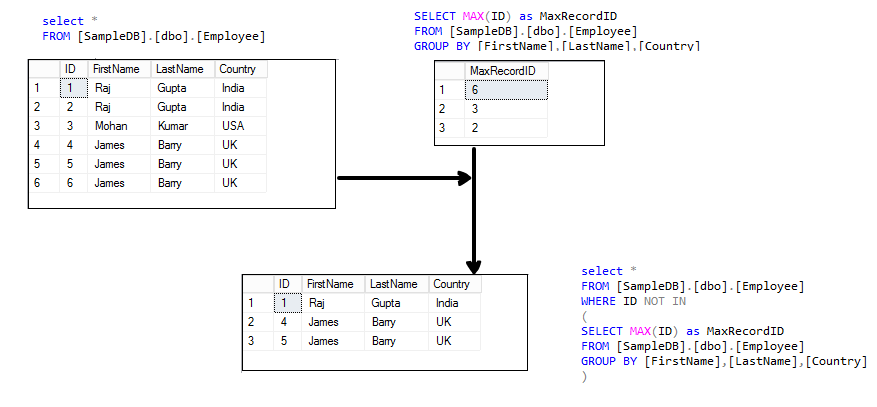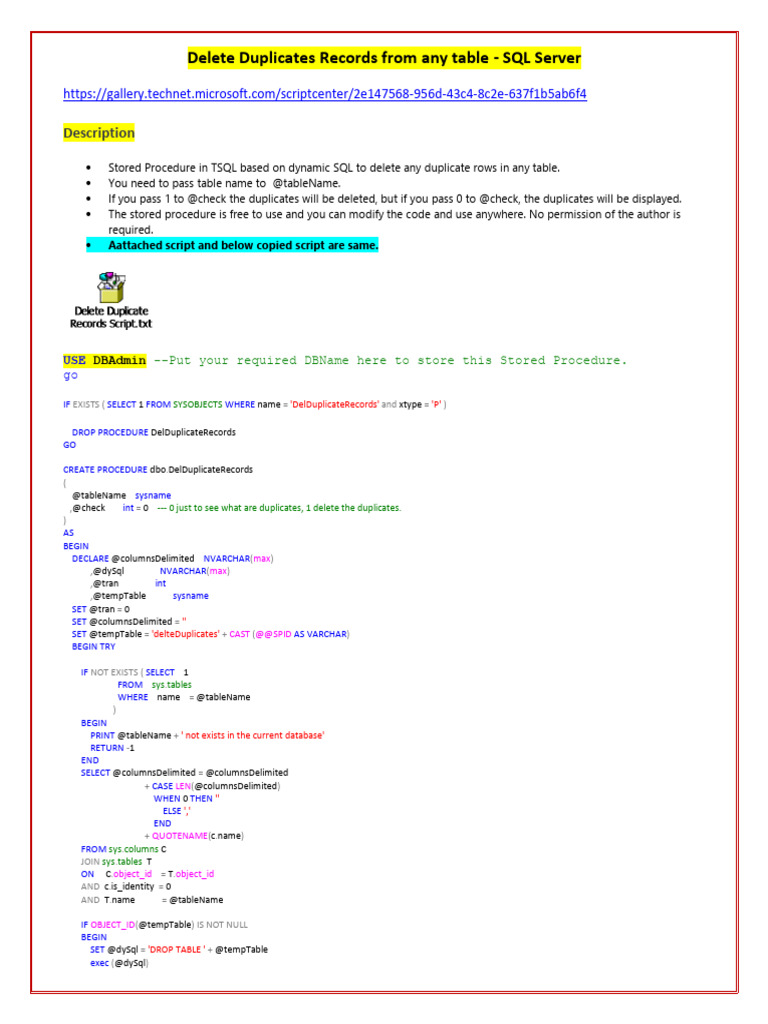3 Ways to Detect SQL Duplicates

In the realm of data management and analysis, handling duplicate records is a common challenge that professionals across industries face. SQL, the standard language for relational database management systems, offers various methods to detect and handle duplicates. This article delves into three effective strategies for identifying and managing duplicate data in SQL databases, providing a comprehensive guide for data professionals.
Understanding the Challenge of SQL Duplicates

Duplicate records can lead to significant issues in data management, impacting the integrity and reliability of databases. These duplicates can arise due to human error, data entry inconsistencies, or complex data integration processes. The presence of duplicate data can result in inaccurate analyses, skewed reports, and inefficient decision-making processes. Therefore, detecting and handling duplicates is a critical aspect of data quality management.
SQL, with its powerful querying capabilities, provides multiple techniques to identify and manage duplicate records. By utilizing these techniques, data professionals can ensure data accuracy, maintain database integrity, and improve overall data quality. This article will explore three effective methods for detecting SQL duplicates, offering practical insights and real-world examples to enhance your data management skills.
Method 1: Utilizing the DISTINCT Keyword

The DISTINCT keyword in SQL is a powerful tool for identifying and handling duplicate records. This keyword allows you to retrieve unique values from a dataset, effectively filtering out duplicates. When combined with other SQL functions and clauses, the DISTINCT keyword becomes a versatile instrument for duplicate detection.
Example: Finding Unique Customer Names
Consider a scenario where you have a customer database with a table named customers, containing columns for customer ID, name, and email. To find unique customer names, you can use the following SQL query:
SELECT DISTINCT name FROM customers;
This query will return a list of unique customer names, excluding any duplicates. The DISTINCT keyword ensures that only distinct values are included in the result set.
Advantages and Considerations
The DISTINCT keyword is simple to use and provides an effective way to identify unique values. However, it’s important to note that this method does not indicate the presence of duplicates. It merely returns a list of unique values. To detect duplicates, you’ll need to compare the results with the original dataset.
Additionally, the DISTINCT keyword can be combined with other SQL functions to perform more complex duplicate detection. For instance, you can use the COUNT function to determine the number of occurrences of each unique value. This can be particularly useful when identifying the extent of duplicate records in your dataset.
Method 2: Grouping and Counting with GROUP BY and HAVING
The GROUP BY and HAVING clauses in SQL provide a more advanced approach to detecting duplicates. These clauses allow you to group data based on specific columns and then apply conditions to filter the results.
Example: Detecting Duplicate Emails
Imagine you want to identify duplicate email addresses in your customer database. You can use the following SQL query:
SELECT email, COUNT(*) AS duplicate_count FROM customers GROUP BY email HAVING COUNT(*) > 1;
This query groups the data by the email column and counts the occurrences of each email address. The HAVING clause filters the results to include only those groups (emails) with a count greater than 1, effectively identifying duplicate email addresses.
Advantages and Applications
The GROUP BY and HAVING clauses offer a powerful way to detect duplicates based on specific criteria. By grouping data and applying conditions, you can identify duplicates in various scenarios. This method is particularly useful when dealing with large datasets and complex duplicate patterns.
Furthermore, you can combine these clauses with other SQL functions to enhance your duplicate detection capabilities. For instance, you can use the SUM function to calculate the total number of duplicates or the MAX and MIN functions to identify the earliest and latest occurrences of duplicates.
Method 3: Utilizing SQL Window Functions for Advanced Duplication Detection
SQL window functions, introduced in SQL:2003, offer a more sophisticated approach to detecting duplicates. These functions allow you to perform calculations across a set of rows related to the current row, making them ideal for advanced duplicate detection.
Example: Identifying Duplicate Orders with Window Functions
Suppose you have an orders table with columns for order ID, customer ID, and order date. To identify duplicate orders (based on customer ID and order date), you can use the following SQL query with window functions:
SELECT order_id, customer_id, order_date, COUNT(*) OVER (PARTITION BY customer_id, order_date) AS duplicate_count FROM orders;
In this query, the COUNT window function, combined with the PARTITION BY clause, calculates the count of occurrences for each combination of customer_id and order_date. The result will include a duplicate_count column, indicating the number of duplicates for each order.
Benefits and Use Cases
SQL window functions provide a flexible and powerful way to detect duplicates, especially in complex scenarios. These functions allow you to perform calculations across a defined window of rows, making them ideal for identifying duplicates based on multiple criteria.
Additionally, window functions can be combined with other SQL constructs to further enhance your duplicate detection capabilities. For instance, you can use the ROW_NUMBER function to assign a unique row number to each record, helping you identify the exact duplicates.
| Method | Advantages |
|---|---|
| DISTINCT Keyword | Simple to use, effective for basic duplicate detection. |
| GROUP BY and HAVING Clauses | Powerful for detecting duplicates based on specific criteria, useful for complex datasets. |
| SQL Window Functions | Sophisticated approach for advanced duplicate detection, ideal for complex scenarios. |

Conclusion: Empowering Data Professionals with Effective Duplicate Detection

Detecting and managing duplicate records is a critical aspect of data quality management. SQL, with its versatile querying capabilities, offers multiple methods to identify and handle duplicates effectively. By understanding and utilizing these methods, data professionals can ensure accurate analyses, maintain database integrity, and enhance overall data quality.
Whether you're a data analyst, database administrator, or developer, mastering these SQL techniques for duplicate detection is essential for your data management toolkit. By applying these methods in your projects, you can tackle duplicate records with confidence and contribute to the success of your data-driven initiatives.
Frequently Asked Questions
What is the significance of detecting duplicates in SQL databases?
+Detecting duplicates in SQL databases is crucial for maintaining data integrity and accuracy. Duplicate records can lead to inaccurate analyses, skewed reports, and inefficient decision-making processes. By identifying and managing duplicates, data professionals can ensure the reliability of their datasets and improve overall data quality.
Can I use the DISTINCT keyword to find duplicates instead of unique values?
+No, the DISTINCT keyword is designed to retrieve unique values from a dataset. To detect duplicates, you’ll need to compare the results obtained with the DISTINCT keyword against the original dataset. This will help you identify the duplicate records.
Are there any limitations to using GROUP BY and HAVING clauses for duplicate detection?
+While GROUP BY and HAVING clauses are powerful tools for duplicate detection, they may not be suitable for extremely large datasets due to performance considerations. In such cases, it’s recommended to explore other methods like SQL window functions or specialized duplicate detection tools.
How can I use SQL window functions for more complex duplicate detection scenarios?
+SQL window functions, combined with PARTITION BY and other window functions like ROW_NUMBER, allow you to perform advanced duplicate detection. You can use these functions to calculate metrics like duplicate counts, assign unique row numbers, and identify exact duplicates based on multiple criteria.



